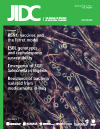Salmonella isolates’ serotypes and susceptibility to commonly used drugs at a tertiary care hospital in Riyadh, Saudi Arabia
DOI:
https://doi.org/10.3855/jidc.1805Keywords:
Salmonella, nalidixic acid resistance, ciprofloxacinAbstract
Introduction: Resistance of Salmonella to therapeutic agents currently being used for treatment of Salmonella infections is emerging as a global problem. This study aimed to assess the prevalence of Salmonella serotypes and their susceptibility patterns to commonly used drugs for treatment of Salmonella infections including quinolones. Correlation between nalidixic acid susceptibility of these isolates and their ciprofloxacin minimum inhibitory concentrations was also sought.
Methodology; Salmonella isolates (n=213) were collected between January 2007 and May 2009 at King Khalid University Hospital in Riyadh, Saudi Arabia. The isolates were serotyped and their susceptibilities to commonly used first-line anti-Salmonella drugs (ampicillin, ceftriaxone, trimethoprim/sulfamethoxazole, nalidixic acid and ciprofloxacin) were determined using the automated Microscan system, the Kirby-Bauer disk diffusion method, and E-test.
Results: The most frequently detected serotype was D1 (37%) followed by the serotypes, B (24%) and C1 (11%). Non-typable Salmonella isolates detected using available conventional Salmonella anti-sera were (11%). Overall resistance rates to nalidixic acid, ampicillin, trimethoprim/sulfamethoxazole and ceftriaxone were 99/213 (46%), 43/213 (20%), 34/213 (16%) and 7/213 (3%), respectively. Of the total isolates, 117 (55%) had a ciprofloxacin MIC of < 0.125 µg/ml and among these 105 (90%) were susceptible to nalidixic acid. The remaining 96 (45%) isolates had a ciprofloxacin MIC of ≥ 0.125 µg/ml and among them, 83 (86.5%) were resistant to nalidixic acid.
Conclusions: The majority of Salmonella isolates in this study were non-typhi serotypes. Significantly higher proportions of Salmonellae were resistant to nalidixic acid and ciprofloxacin and a vast majority of nalidixic acid resistant organisms exhibited decreased susceptibility to ciprofloxacin.
Downloads
Published
How to Cite
Issue
Section
License
Authors who publish with this journal agree to the following terms:
- Authors retain copyright and grant the journal right of first publication with the work simultaneously licensed under a Creative Commons Attribution License that allows others to share the work with an acknowledgement of the work's authorship and initial publication in this journal.
- Authors are able to enter into separate, additional contractual arrangements for the non-exclusive distribution of the journal's published version of the work (e.g., post it to an institutional repository or publish it in a book), with an acknowledgement of its initial publication in this journal.
- Authors are permitted and encouraged to post their work online (e.g., in institutional repositories or on their website) prior to and during the submission process, as it can lead to productive exchanges, as well as earlier and greater citation of published work (See The Effect of Open Access).








